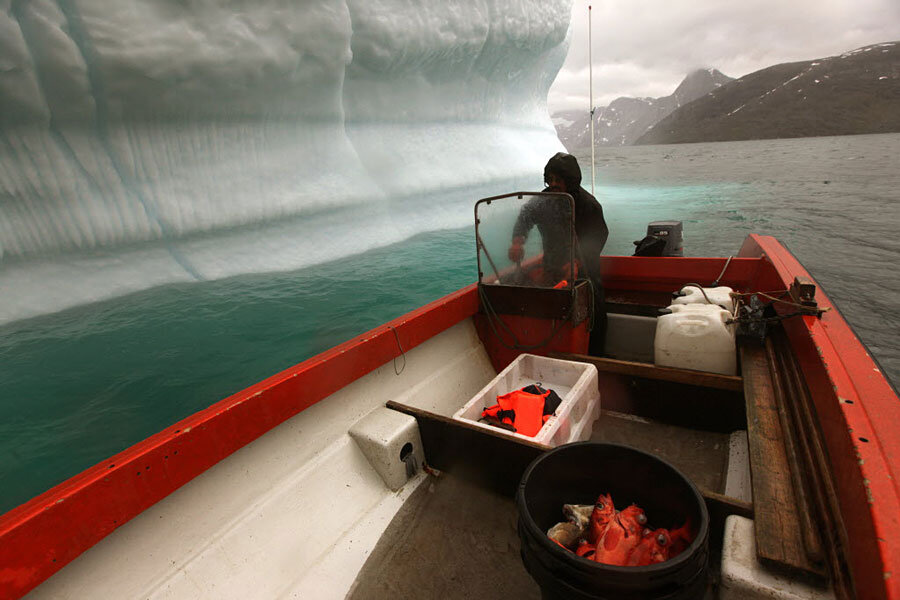Can scientists hear Greenland's ice sheets melting?
Loading...
Glacial melt has largely been monitored from the sky either by satellites or airplanes, but now scientists are trying to not just see, but hear changes to the glaciers.
Researchers listening to vibrations in the Earth's crust beneath Greenland's ice sheets found that changes in those shakes correlated with periods of time when the region's glaciers melted. The team describes the new technique in a paper published Friday in the journal Science Advances.
The seismic waves these scientists are listening to aren't the shudders of a massive chunk of ice breaking off of Greenland's ice sheets, although that has been observed. These are small vibrations passing through the Earth's crust constantly.
Their source: the rhythmic drum of waves crashing and splashing against Greenland's coastline.
The crashing surf creates ambient seismic noise that reverberates throughout the Earth's crust all the time. Exactly how these seismic waves move through the ground can tell the scientists valuable information about those crustal rocks, including how much weight an ice sheet might be putting on them.
"Seismic waves can be very sensitive to tiny changes in the medium they cross," explains study lead author Aurélien Mordret, a postdoc in the Department of Earth, Atmospheric and Planetary Sciences at Massachusetts Institute of Technology, in an email to The Christian Science Monitor.
"As they travel through a medium, they accumulate information about it all along the path."
One piece of information that influences how these vibrations move through the crust is how porous the rocks are. Seismic waves move more slowly through more porous rocks.
The scientists suspected that the weight of an ice sheet atop these rocks might press cavities closed and therefore change the velocity of the seismic waves. If so, a shrinking ice sheet would mean slower seismic waves and vice versa.
To test their idea, the scientists listened to the seismic noise picked up by seismometers on the western side of Greenland's ice sheet from January 2012 to January 2014.
In 2012, Greenland's ice sheet lost about 500 gigatons of mass. That massive melt was picked up by NASA's Gravity Recovery and Climate Experiment (GRACE) satellites, but the seismometers also picked up on the change: the seismic waves slowed significantly.
Thus far, ice sheet melt has been largely monitored by satellite imagery and laser measurements of an ice sheet's topography from airplanes. But this new technique could increase the precision of such efforts.
"GRACE, for example, cannot see mass variations smaller than 300-400 km (186-249 miles) in lateral extension. With our technique, we are only limited by the separation between the seismometers," Dr. Mordret says.
Not only can the seismometers narrow in on specific locations on ice sheets, this technique also can monitor the melt constantly. The continuous seismic noise of the crashing waves means that the signal is being transmitted 24 hours a day, seven days a week. The satellite-based monitoring systems only pick up changes when they pass over a region.
"This technique was originally developed to monitor volcanoes and active seismic fault zones, to see precursory changes prior to volcanic eruptions and to observe how the Earth's crust behaves after a large earthquake," Mordret says. But the team already plans to see if the same technique can be applied on other rapidly melting ice sheets, like those in West Antarctica.
And because the meltwater from these massive ice sheets pours directly into the oceans, "this study will help to calibrate and provide more accurate projection of global sea level rise," he explains.
"If all the ice from the Greenland and the Antarctica ice sheets was to melt, it would increase the global sea level by 60 to 80 m (197 to 262 feet). The Greenland ice sheet alone would contribute more than 7 m (23 feet)," Mordret says. "It is therefore paramount to accurately monitor the melt rate of ice sheets to better predict the evolution of sea level change."
"These models and projections will then be used by politics and decision-makers to help people face these climate change threats."






